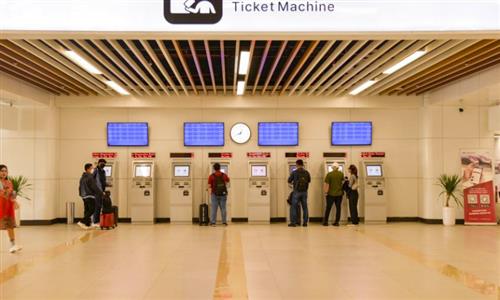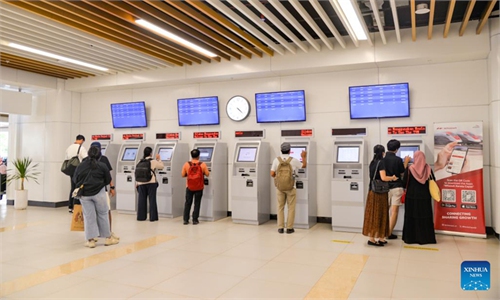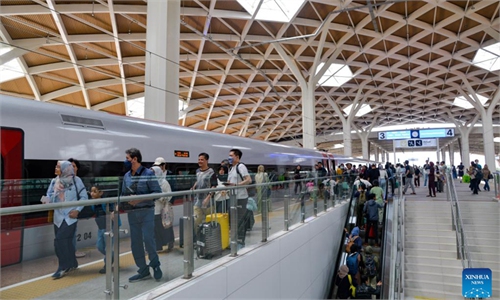Jakarta-Bandung High-Speed Railway celebrates one-year anniversary, opening new chapter for regional prosperity and development
Path to boom
On October 17, the Jakarta-Bandung High-Speed Railway (HSR) celebrated its first year of operation, with the Halim Station in Jakarta, Indonesia, being filled with a joyful atmosphere. The achievements and highlights of the HSR over the past year were displayed through a huge screen, vividly showcasing how the railway has changed the lives of Indonesian people.
Chinese President Xi Jinping said on October 14 that China is willing to work with Indonesia to jointly promote high-quality Belt and Road cooperation, ensure the sustainable operation of the Jakarta-Bandung High-Speed Railway, and create more highlights of cooperation to better benefit the people of both countries. Xi made the remarks during his phone talks with then Indonesian president Joko Widodo.
Widodo expressed gratitude to China for contributing to Indonesia's economic development, noting that the Jakarta-Bandung High-Speed Railway has become a model for Belt and Road cooperation between the two sides.
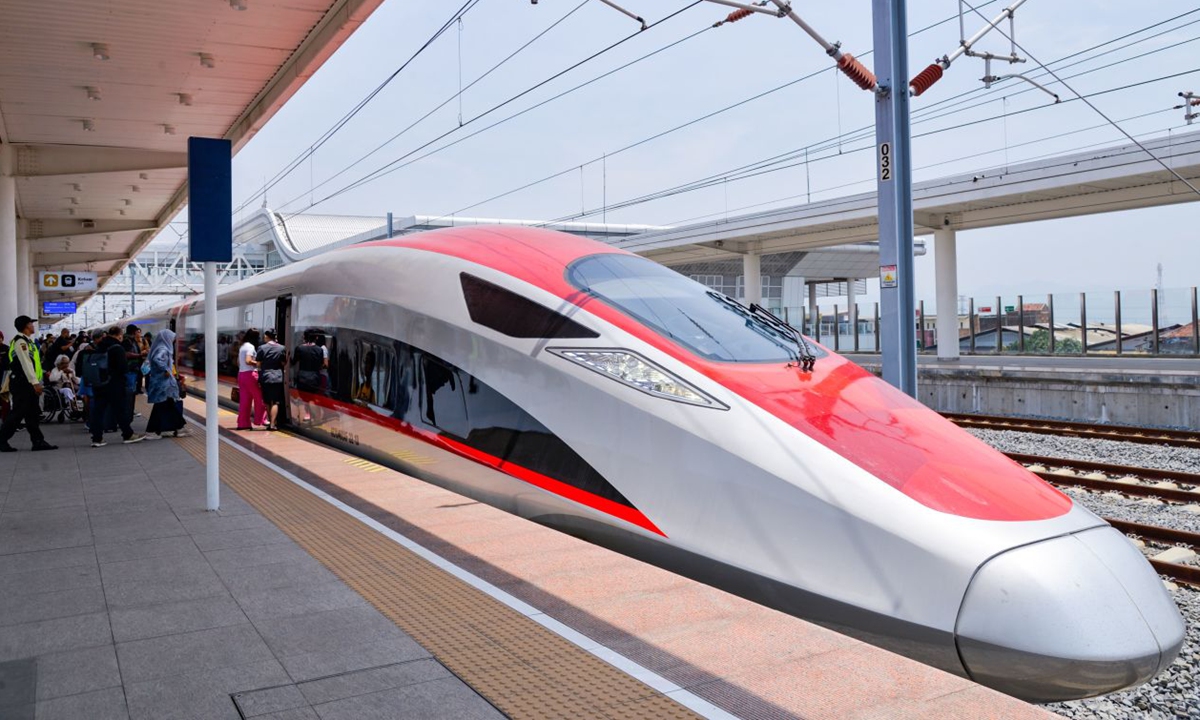
Passengers board a high-speed electrical multiple unit (EMU) train on a platform of Padalarang Station along the Jakarta-Bandung High-Speed Railway (HSR) in Padalarang, Indonesia, October 17, 2024. Photo: Xinhua
On the first anniversary of the Jakarta-Bandung High-Speed Railway (HSR) opening, a delegation from the People's Daily arrived in Indonesia. After landing, they went to Halim Station to take the G1231 train for on-site interviews. They experienced firsthand the significant changes brought about by the HSR over the past year in improving local livelihoods and promoting economic development in Indonesia. It has truly become a path for development, livelihoods, and a win-win approach for the Indonesian people. Additionally, it provides valuable experience and a successful model for the future railway development in Indonesia and Southeast Asia.
Promoting the improvement of people's livelihoods and well-being
Just as the reporters boarded the train, they began chatting with two staff members in the carriage. One of the staff members Alifa, had just celebrated her 23rd birthday and had been working on the HSR for half a year. "Why do you like working on the HSR?" the reporters asked. She pointed to the screen in the carriage displaying "347 kilometers per hour" and said, "Because of passion and efficiency!" The other staff member Visma nodded in agreement.
Indonesia is the place where President Xi first proposed the 21st Century Maritime Silk Road. The Jakarta-Bandung High-Speed Railway is a "golden signboard" of cooperation between China and Indonesia under the Belt and Road Initiative (BRI).
In October 2023, President Xi and then Indonesian president Widodo jointly inaugurated the official operation of the Jakarta-Bandung High-Speed Railway.
As a flagship project of the China-Indonesia Belt and Road cooperation, which has received personal attention and promotion from both heads of state, the sustainable operation of the HSR over the past year has improved the lives of local residents and benefited the Indonesian people.
Since its opening, the HSR has facilitated 5.79 million passenger trips, with its peak daily occupancy rate reaching 99.6 percent. The HSR has safely completed trips covering over 2.57 million kilometers, according to the Xinhua News Agency.
"The presence of Whoosh provides a new landscape for connectivity. It has earned public applause and proves that Indonesia is not just a country that follows but one that leaps forward," Indonesian Minister of Transportation Budi Karya Sumadi said during the anniversary celebration in East Jakarta, according to Xinhua.
In Indonesia, the HSR is known by a familiar name - "Whoosh." The term is an acronym in Indonesian for "time-saving," "efficient," and "advanced," and it mimics the sound of the high-speed train rushing by, vividly showcasing the swift nature of the HSR.
At Halim Station, Fania Isfandiari Arifah is planning to take the HSR back home in Bandung. Previously, she would drive for over three hours to get home once a week. For her, with the HSR, the distance between Bandung and Jakarta has greatly shortened. She can now get home in less than an hour. The HSR has significantly changed her life, and she now has more time to spend with the family, she told the reporters.
When the reporters took the G1248 from Tegalluar Station in Bandung back to Jakarta, they saw four middle-aged women taking photos against the backdrop of the HSR outside the waiting hall. The women said they had traveled from Jakarta to Bandung for a day trip and were taking pictures to share with friends and family.
One of the women, named Susi, proudly showed the reporters a video she had taken, gesturing as she said that she did a coin rolling experiment on the train and found that even though the high-speed train is going so fast, it is just as smooth as on flat ground.
Fania and Susi's experiences are a microcosm of the feelings of many passengers on the HSR. The HSR acts as a link, closely connecting Jakarta and Bandung, providing a safe, green, efficient, and comfortable travel option that is highly favored by the people along the route.
At Halim Station, the head of the station Ade Iskandar occasionally communicates with staff via intercom to ensure that all operations at the station are running smoothly. He has been the station head for two years and has witnessed the entire process of the station's development from nothing to a busy operational hub.
He said Halim Station is now not just a transportation hub serving passengers, but also a small commercial area providing shopping and dining conveniences, attracting hundreds of shops and increasing the economic benefits for many residents along the route.
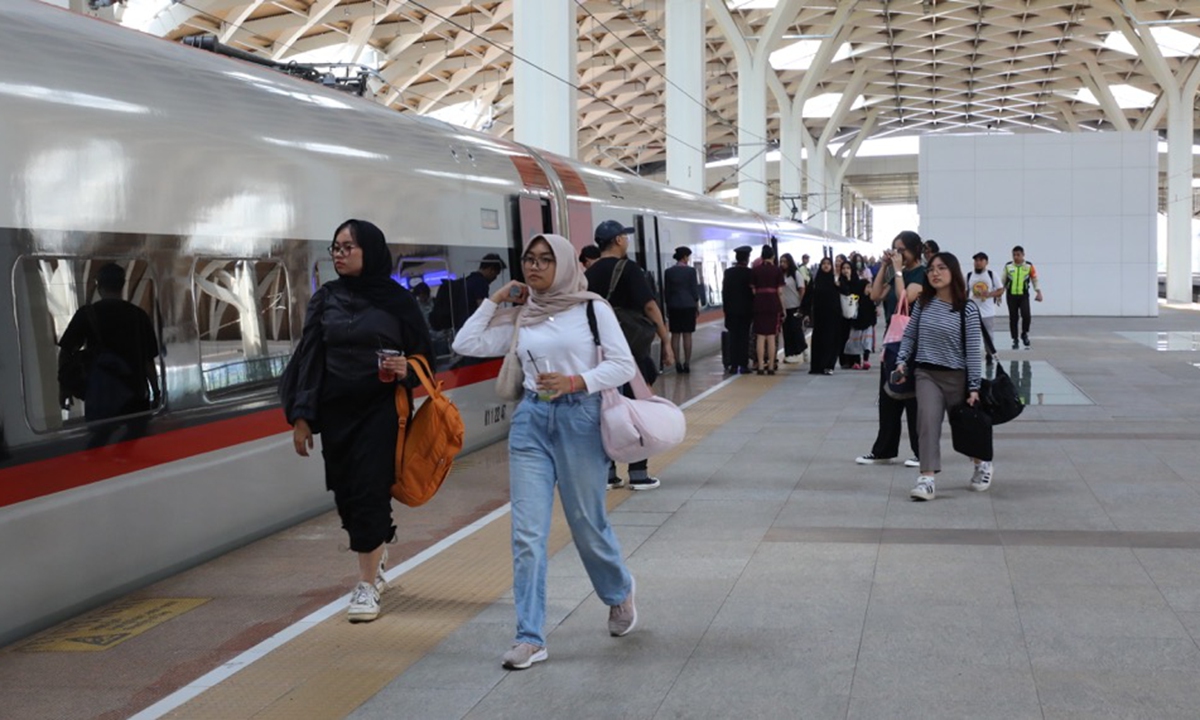
Passengers wait to board the train at Halim Station, the terminal of the Jakarta-Bandung High-Speed Railway in Jakarta, Indonesia, in April 2024. Photo: Cao Shiyun/GT
Continuing to support Indonesia's economic development
The HSR connects Indonesia's political and economic center - Jakarta and Bandung. As the first high-speed railway in Indonesia and Southeast Asia, the HSR is not only a modern transportation artery linking the two cities but also has a tremendous radiating and driving effect on the development of the surrounding areas, effectively pressing the "fast forward" button on economic growth along the route.
Indonesian government data indicated that between 2019 and 2023, the HSR project contributed 86.5 trillion rupiahs ($5.62 billion) to the GDP of Jakarta and West Java, according to Xinhua.
From Halim Station, it takes about 15 minutes to reach Karawang Station, which is surrounded by numerous well-known industrial parks covering sectors such as automobile manufacturing, electronics, and home appliances, making it a crucial pillar of Indonesia's industrial development.
Within the PT. Kawasan Industri Terpadu Indonesia China, located about 10 kilometers from Karawang Station, more than 50 well-known companies from various countries and regions, including China, the US, New Zealand, and Finland, have gathered, creating a busy and orderly scene. The wide roads in the park are lined with neatly arranged factories and modern office buildings, with heavy trucks frequently coming and going, loading and unloading goods in an orderly manner.
"The Karawang Station is expected to open next year, which will be of great significance for the development of the park," Liu Weiming, chairman of PT. Kawasan Industri Terpadu Indonesia China told the reporters.
"The road traffic from Jakarta to the park has always been quite congested, significantly affecting the logistics and transportation efficiency of the park's enterprises. When the station opens, it will greatly alleviate transportation pressure, facilitate staff commuting, and make connections between the park, Jakarta, and nearby ports and airports much smoother, significantly reducing time costs, fuel expenses, and environmental pollution. At that time, the park will become more attractive to investors, drawing in more companies," said Liu.
As the train proceeds forward, the breathtaking landscapes of Bandung reveal themselves to the delegation. Gentle hills and verdant rice paddies are dotted with serene villages, while meandering rivers occasionally come into view. Dubbed as the "Paris of Java," Bandung is known for its abundant natural beauty and rich cultural heritage. The HSR is set to invigorate the city's tourism sector, ushering in new drivers for growth and opportunity.
The HSR has also effectively driven a new wave of growth in the local tourism sector. According to PT Kereta Cepat Indonesia-China, a joint venture consortium between Indonesian and Chinese firms that constructs and runs the HSR, the HSR has transported 5.79 million passengers by Thursday this year, including 300,000 international tourists from 159 countries, according to Xinhua.
In May of this year, the number of tourists in West Java increased by 94.84 percent compared to the previous month; and the number of visitors to Bandung has grown by approximately between 10 percent and 15 percent this year, according to media reports.
To enhance travel experience, the HSR has partnered with over a dozen tourist attractions in Bandung to launch "high-speed rail tourism" packages, allowing ticket holders to enjoy free shuttle services, waived entrance fees, and discounts on meals and accommodations.
Dodi Ahmad Sopandi, chairman of the West Java Regional Executive Board of Indonesian Hotel and Restaurant Association, said that the opening of the HSR has significantly boosted Bandung's tourism industry.
With many tourists going to Bandung, the hotel occupancy rates and restaurant revenues in the surrounding areas have surged, revitalizing related industries. The HSR has not only injected vitality into the tourism sector but has also brought new opportunities for the economic development of the entire region, he said.
He said that they hope in the future, local regional governments will continue to strengthen cooperation with the HSR to jointly promote further economic growth in the region.
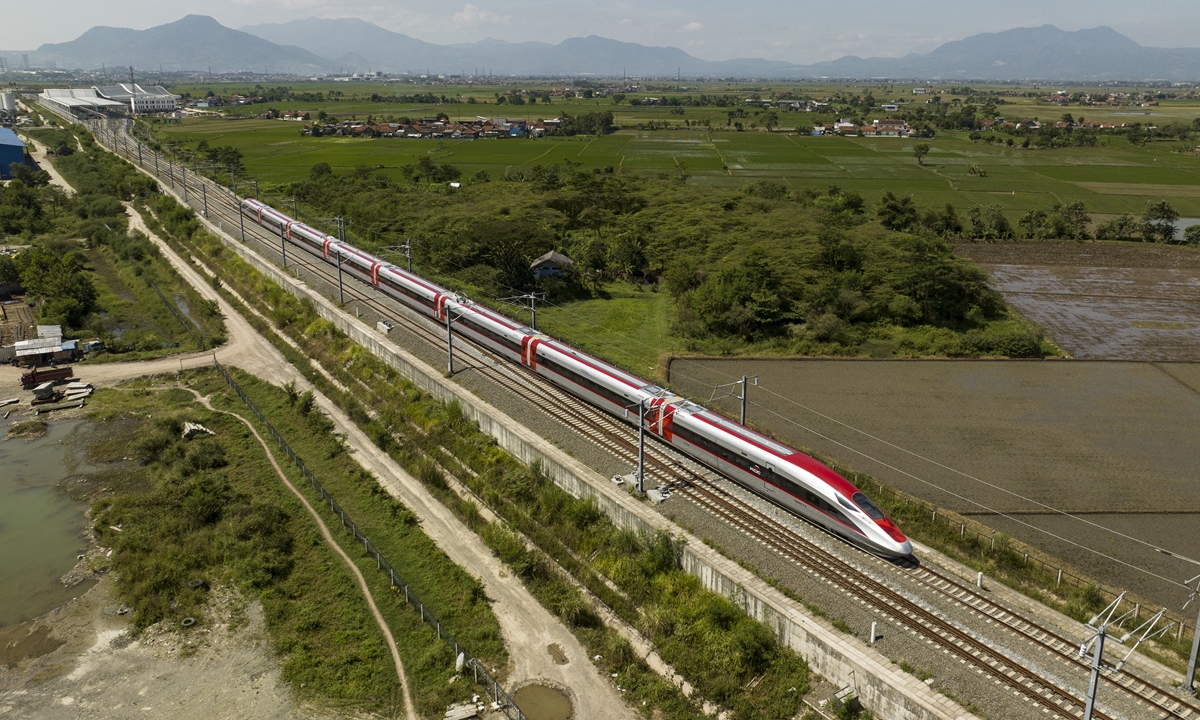
The Jakarta-Bandung High-Speed Railway in Indonesia Photo: IC
Creating new opportunities for regional connectivity
The HSR made Indonesia the first country in Southeast Asia to possess a high-speed train capable of reaching speeds of 350 kilometers per hour, marking its entry into the high-speed rail era and serving as a successful example of collaborative modernization between China and regional partners.
As the first high-speed railway in Indonesia and Southeast Asia, the HSR is a model for China's high-speed rail to achieve the construction of the entire system and the entire industrial chain overseas for the first time. The entire project adopts Chinese technology and standards, showcasing the strong capabilities of China's high-speed rail industrial chain in all aspects, from surveying and design to engineering construction, equipment manufacturing, and operational management.
Through the project, China has showcased its robust capabilities in high-speed rail technology innovation and engineering management, highlighting its hard-core strength from research and development to project implementation.
The successful construction and smooth operation of the project not only adds a new "national emblem" for Indonesia but also symbolizes the modernization of transportation in Southeast Asia, serving as an important model for further cooperation between China, Indonesia, and other countries and regions in infrastructure and transportation.
Widodo said at the opening ceremony of the project in October 2023, that the HSR marked the modernization of Indonesia's transportation mode, according to Xinhua.
Kao Kim Hourn, secretary-general of the Association of Southeast Asian Nations (ASEAN), highly praised the exemplary significance of HSR as it is the first one in Indonesia and Southeast Asia, when took a test ride in September 2023, according to Mission of China to ASEAN.
The HSR has garnered widespread attention and positive responses in Southeast Asia, providing valuable experiences for other countries in the region. Some countries such as Thailand and Malaysia have expressed keen interest, accelerating their own high-speed rail project planning and implementation.
The HSR not only fills the gap in Indonesia's high-speed rail sector but also sets a benchmark for the Southeast Asian region, said Fajar Hirawan, senior researcher at Business and Economic Research Institute (BERI).
The demonstration effect of the HSR will promote the advancement of high-speed rail projects in other countries in the region, creating new opportunities for enhancing connectivity in Southeast Asia and further strengthening the economic integration process within ASEAN, said the researcher.

Travelers rest and dine in the fast food area at Halim Station in Jakarta, Indonesia, in August 2024. Photo: Cao Shiyun/GT
Promoting sustainable operations
In the year since its opening, China has actively promoted the sustainable operation of the HSR, providing comprehensive support in technology, equipment maintenance, and personnel training.
Zhang Chao, finance and risk management director of PT Kereta Cepat Indonesia-China (KCIC), said that following the launch of operations, they have proactively adapted to the growing passenger demand, offering transportation services during month of Ramadan and the festival of Eid al-Fitr, optimizing train schedules and increasing capacity.
The number of daily train services has risen from 14 at the start to a peak of 52, with a maximum daily passenger volume of 24,000. Continuous improvements in passenger services have created a smooth, efficient, and comfortable travel environment, along with a flexible pricing policy offering more choices for travelers, according to Zhang.
"China and Indonesia have jointly established a management team to train 600 local Indonesian personnel for 23 positions, including high-speed train drivers and train mechanics. Among them, 114 trainees are currently in class, and 160 have completed their qualification training and are about to start practical training. This initiative aims to enhance the localized operational management capabilities of the HSR, further polishing the 'golden brand' of this project," said Hu Ming, head of the Jakarta-Bandung High-Speed Railway (international) project management team from China Railway Beijing Group Co.
"Whoosh is a result of Chinese innovation, which has made Indonesia more competitive on the global stage, particularly in Southeast Asia," Indonesian Minister of Transportation Budi Karya Sumadi said during the anniversary celebration in East Jakarta, according to Xinhua.
On the G1231 train, 30-year-old Sandy said this is historic, and that he is honored to be a part of it. Over the past year, Sandy has seen many tourists from Malaysia, Thailand, and even Europe and America. What amazes them the most is how the train can travel at 350 kilometers per hour so smoothly and comfortably, Sandy said.
Allan Tandiono from KCIC said that the training provided by China has offered valuable learning opportunities for Indonesian engineers and workers, promoting technical exchange between the two countries and laying a solid foundation for the successful implementation of similar projects in the future.
Luhut Binsar Pandjaitan, Indonesia's coordinator for cooperation with China and coordinating minister of maritime affairs and investment, expressed confidence in the sustainable operation of the HSR. He believes it will bring greater convenience and improvements to the transportation environment for the Indonesian people.
